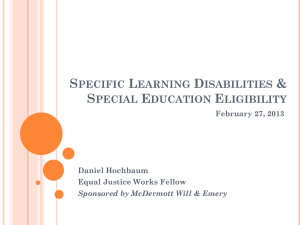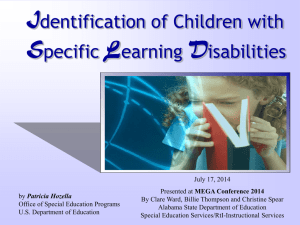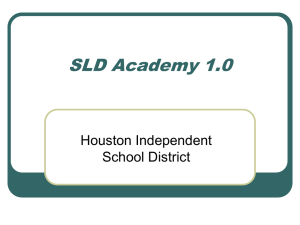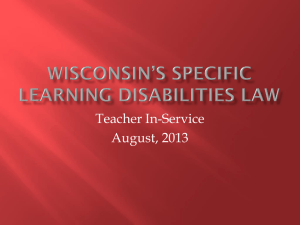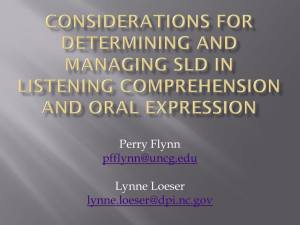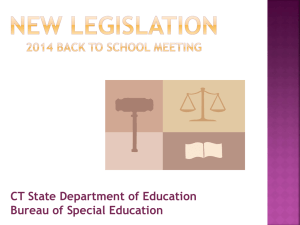History of IDEA - ADE Special Education
advertisement
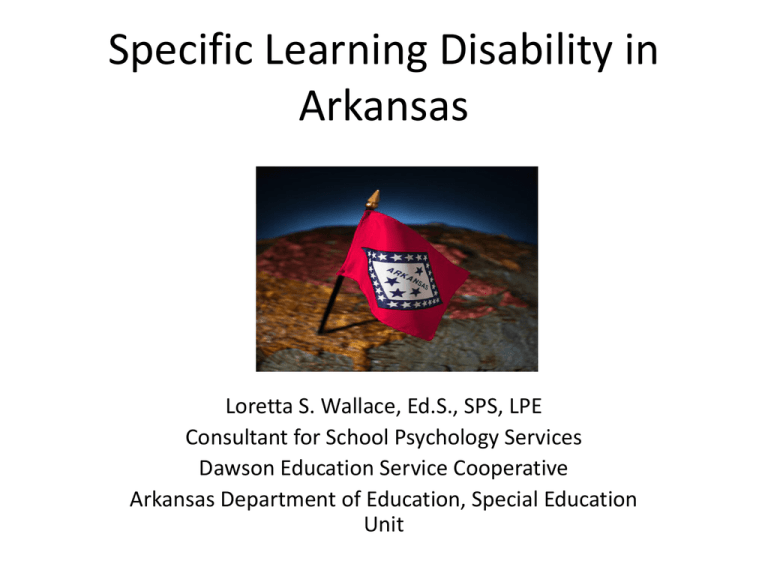
Specific Learning Disability in Arkansas Loretta S. Wallace, Ed.S., SPS, LPE Consultant for School Psychology Services Dawson Education Service Cooperative Arkansas Department of Education, Special Education Unit IDEA Regulations for SLD • Add procedures for identification • Add criteria for determining SLD • Requires additional group members • Describes required observation • Specifies documentation A Close Look at §300.307 State must adopt criteria* for determining whether a child has an SLD as defined in IDEA Public agencies must use State criteria in determining whether a child has an SLD Produced by NICHCY, 2007 * Consistent with §300.309 of Part B A Close Look at §300.307 State criteria may not require use of severe discrepancy between intellectual ability and achievement for determining whether a child has an SLD State criteria must permit use of a process based on the child's response to scientific, research-based intervention State criteria may permit use of other alternative researchbased procedures. Produced by NICHCY, 2007 Group Determining SLD Determination of SLD is made by child’s parents and a team of qualified professionals, which must include: Child’s regular teacher If child does not have a regular teacher: A regular classroom teacher qualified to teach a child of his or her age If child is less than school age: An individual qualified by SEA to teach a child of his or her age Produced by NICHCY, 2007 Group Determining SLD At least one person qualified to conduct individual diagnostic examinations of children… Such as… school psychologist speech-language pathologist remedial reading teacher Produced by NICHCY, 2007 Criteria for Determination The child does not achieve adequately for the child’s age or to meet State-approved gradelevel standards in one or more of the following areas, when provided with learning experiences and instruction appropriate for the child’s age or State-approved grade–level standards: Determining SLD Oral expression Listening comprehension Written expression Basic reading skill Reading fluency skills Reading comprehension Math calculation Math problem solving and… Produced by NICHCY, 2007 Determining SLD Child’s progress in 1 (or more) of these 8 areas is not sufficient to meet age or State-approved grade level standards when his or her response to scientific, researchbased intervention is part of determination process Child exhibits a pattern of strengths and weaknesses in performance, achievement, or both: age Relative to: State-approved grade level standards, or intellectual development Produced by NICHCY, 2007 …that group determines is relevant and… to identification of SLD Determining SLD Group determines that its findings are not primarily the result of: Visual, hearing, or motor disability Mental retardation Emotional disturbance Cultural factors Environmental or economic disadvantage Limited English proficiency Produced by NICHCY, 2007 Determining SLD Purpose: To ensure child’s underachievement is not due to lack of appropriate instruction in reading or math Group must consider data in 2 areas: Data showing that child was provided appropriate instruction in regular education settings, delivered by qualified personnel, before (or as part of) referral process and… Produced by NICHCY, 2007 Determining SLD Data-based documentation that child’s achievement was repeatedly assessed at reasonable intervals This documentation: Reflects formal assessment of student progress during instruction Was provided to the child's parents Produced by NICHCY, 2007 Determining SLD Public agency must promptly request parent consent for evaluation: Whenever child is referred for evaluation If, before referral for evaluation, child has not made adequate progress… after appropriate period of time when provided appropriate instruction by qualified personnel Produced by NICHCY, 2007 Observation in SLD Determination Public agency must ensure: Child is observed in his or her learning environment (including the regular classroom setting) to document child's academic performance and behavior in the areas of difficulty Produced by NICHCY, 2007 Observation in SLD Determination Group must decide whether to: Use information from observation done before child was referred for an evaluation routine classroom instruction monitoring of child's performance Have at least one group member conduct observation after child has been referred for evaluation and parental child’s academic consent performance in regular classroom Observation in SLD Determination Observation of child less than school age or out of school: Group member must observe child in environment appropriate for a child of that age Produced by NICHCY, 2007 Documenting the Determination of Eligibility For a child suspected of having SLD, documentation of determination of eligibility must contain a statement of 7 elements: 1. Whether child has a specific learning disability 2. Basis for making the determination* and… * …including assurance that qualified professionals and child’s parent determined child was a “child with a disability” and his or her educational needs Produced by NICHCY, 2007 Documenting the Determination of Eligibility 3. Relevant behavior (if any) noted during observation of child and relationship of that behavior to child's academic functioning 4. Educationally relevant medical findings (if any) and… Produced by NICHCY, 2007 Documenting the Determination of Eligibility 5. Whether child does not achieve adequately: for the child's age, or to meet Stateapproved grade-level standards* Produced by NICHCY, 2007 and… * Consistent with §300.309(a)(1) Documenting the Determination of Eligibility 5. Continued… Child does not make sufficient progress to meet age or State grade-level standards ** Child exhibits pattern of strengths and weaknesses in performance, achievement, or both, relative to age, State grade-level standards or intellectual development *** ** *** Consistent with §300.309(a)(2)(i) Consistent with §300 .309(a)(2)(ii) and… Documenting the Determination of Eligibility 6. What the group has determined concerning effects on the child's achievement level of— Visual, hearing, or motor Mental retardation disability Emotional disturbance Cultural factors Environmental or economic Limited English Produced by NICHCY, 2007 disadvantage proficiency and… Documenting the Determination of Eligibility 7. If child has participated in a process assessing his or her response to scientific, research-based intervention— instructional strategies used and studentcentered data collected; and documentation that child's parents were notified about 3 things, as follows… Produced by NICHCY, 2007 Documenting the Determination of Eligibility …that child's parents were notified about— State's policies regarding amount and nature of student performance data that would be collected and general education services that would be provided Strategies for increasing the child's rate of learning Parents' right to request an evaluation Produced by NICHCY, 2007 Documenting the Determination of Eligibility Each member of group must certify in writing whether report reflects the member's conclusion If report does not: Member must submit a separate statement presenting his or her conclusions Produced by NICHCY, 2007 What has not changed for us? • • • • • Definition of SLD Possible Referral Characteristics Screening Information Optional Evaluation Data Required Evaluation Data – Except changes made to observation Where can we find the changes in Arkansas Rules and Regulations? • Re: observation, in IV Required Evaluation Data section • In VI Evaluation Data Analysis – Includes allowable methods, criteria, and documentation What are the allowable methods for SLD determination in Arkansas? • Public agencies may use severe discrepancy but it is not required • Public agencies may use a process based on the child’s response to scientific, researchbased intervention • Public agencies may use other alternative research-based procedures Options in Revised Regulations N States Our regs require the use of 6 response to scientific, research-based intervention and do not allow use of severe discrepancy in establishing eligibility for SLD Colorado, Delaware, Georgia, Indiana, Iowa, West Virginia Our regs allow the use of either response to scientific, research-based intervention or severe discrepancy in establishing eligibility for SLD (i.e., LEA chooses which approach to use for all such determination) 26 Alaska, California, Idaho, Kentucky, Maine, Minnesota, Mississippi, Missouri, Montana, Nevada, New Jersey, New Mexico, New York, North Carolina, North Dakota, Oklahoma, Pennsylvania, Rhode Island, South Dakota, Tennessee, Texas, Utah, Virginia, Vermont, Washington, Wyoming Our regs allow response to scientific, research-based intervention, severe discrepancy or any other research-based alternative to be used in establishing eligibility for SLD 10 Alabama, Arkansas, Florida, Kansas, Michigan, Nebraska, New Hampshire, Ohio, Oregon, South Carolina References and Resources • Ahearn, E.M., (2008). State eligibility requirements for specific learning disabilities. National Association of State Directors of Special Education, inForum brief policy analysis: http://www.nasdse.org/ • Arkansas Department of Education, Special Education Unit Procedural Requirements and Program Standards; Eligibility Criteria and Program Guidelines for Children with Disabilities, 2008. www.arksped.k12.ar.us • Individuals with Disabilities Education Improvement Act of 2004, Pub. L. No. 108-446, § 118 Stat. 2647 (2004). References and Resources • Lichtenstein, R. & Klotz, M.B. (2007). Deciphering the federal regulations on identifying children with specific learning disabilities. NASP Communique, 36(3). • National Association of School Psychologists. (2007). Identification of students with specific learning disabilities (Position Statement). Bethesda, MD: Author. • National Joint Committee on Learning Disabilities. (2010). Comprehensive assessment and evaluation of students with learning disabilities. Available from www.ldonline.org/njcld References and Resources • National Joint Committee on Learning Disabilities. (2011). Learning disabilities: implications for policy regarding research and practice. Available from www.ldonline.org/njcld • National Dissemination Center for Children with Disabilities, www.nichcy.org • U.S. Department of Education, Office of Special Education and Rehabilitative Services, Office of Special Education Programs: http://www2.ed.gov/about/offices/list/osers/osep/index.html Contact Loretta S. Wallace, Ed.S., LPE, SPS Consultant for School Psychology Services Dawson Education Service Cooperative Arkansas Department of Education, Special Education Unit 501-835-3330 Loretta.wallace@arkansas.gov
